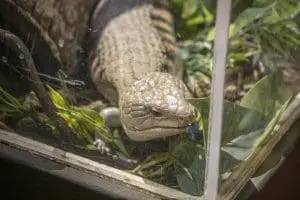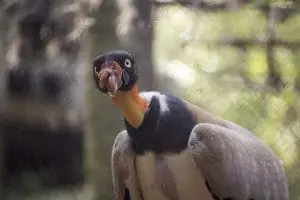

Happy Halloween! We hope you and yours are having a scary good time.
We have a few animal residents who are a little tricky and maybe a little spooky too! Read on for some Halloween-themed fun.
 Alligator Snapping Turtle
Alligator Snapping Turtle
This trickster uses their long tongue to look like the perfect treat for their prey – they’ll just leave their mouth open and flail their tongue around. Any unsuspecting fish, frogs, and any other animals that get too close are snapped up.
Stop by Capone the alligator snapping turtle’s habitat in our Wild Florida loop to see if he’s “going fishing” with his tongue.
 Blue-tongued skink
Blue-tongued skink
This is another trickster who flashes their bright blue tongue to discourage predators from taking a bite out of the skink! Brightly colored skin or scales is often a sign that an animal is poisonous or venomous. Not so with a blue-tongued skink – they’re just con artists!
Our blue-tongued skinks, Skye and Azure, are animal ambassadors, so their habitats are behind-the-scenes. Each of them makes occasional visits to the front of the Zoo on weekdays at 11 a.m. for Animal Encounters, however.
Great Horned Owl
We can’t have a spooky-themed Halloween post without including a creature of the night! Everything about our great horned owl Horatio is made for life at night, from her powerful talons to her excellent hearing. Her eyes are designed to see best at night with their cylinder shape, which prevents this creature from being able to move them. No worries, Horatio can rotate her neck 270 degrees to get a good look around her (Did we all get a visual of a certain spooky movie?). Pair that with nearly soundless flight thanks to her fringed feathers, and you have an ultimate nighttime predator.
You can spot Horatio in her habitat in our Rainforest Revealed loop – yes, even during the day! She may not be fully awake, though.
 King Vulture
King Vulture
Vultures get a bad rap for their zombie-like dinner choices of decaying animals, but their role is so important in any ecosystem. Their cleanup work removes diseases and poisons from the environment before they have a chance to spread and affect other animals. Their corrosive stomach acid keeps them from becoming sick from eating carcasses infected by diseases like rabies.
You can see our flock of king vultures, including 6-month-old Freddie, in their habitats in Rainforest Revealed.
 Poison Dart Frogs
Poison Dart Frogs
Unlike some of the other animals in this post, our poison dart frogs’ “costumes” are no trick! Their bright colors serve as a warning to predators that these pint-sized amphibians are toxic. The poisons in these frogs comes from their diet in their natural range – ants, termites, centipedes and beetles. They often lose their toxicity in a Zoo setting, especially if they were born in human care.
Check out our army of poison dart frogs at the Venom House in Rainforest Revealed!
Spookily named Zoo residents:
- Galloping Ghost the Ankole-Watusi
- Morticia and Gomez the wrinkled hornbills
- Wednesday the Chilean rose tarantula
Brevard Zoo is an independent, not-for-profit organization that receives no recurring government funding for our operating costs. Your generous support enables us to continue to serve our community and continue our vital animal wellness, education and conservation programs.
